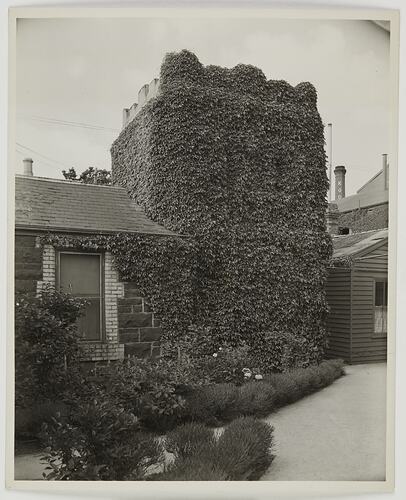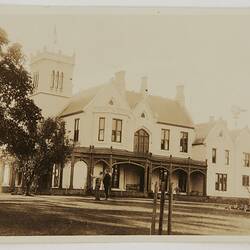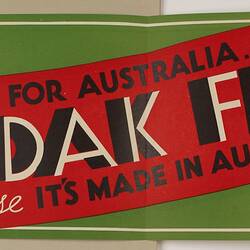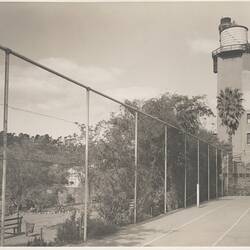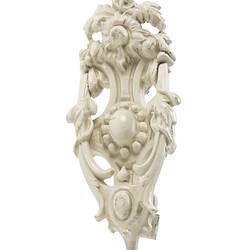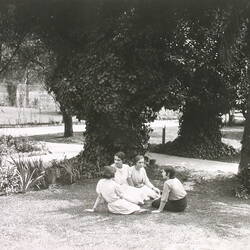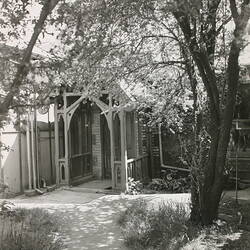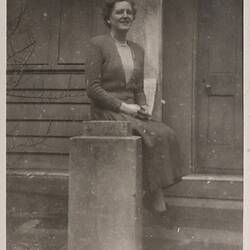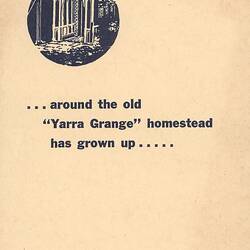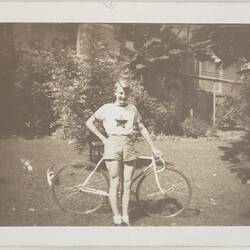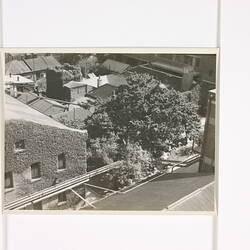Yarra Grange - Home of Thomas & Alice Baker
A Grand Home by the Yarra River
In 1884 Thomas and Alice Baker purchased 'Yarra Grange', a grand bluestone house located on about 7 acres with Yarra River frontage. It was located on Southampton Crescent in the inner-city suburb of Abbotsford, across the river from Studley Park.
Yarra Grange was just around the corner from the Baker's previous house in South Audley Street, but was a marked step up in grandeur and status. It had an attractive outlook onto gum trees with direct access to the river, and featured a luxurious house in established gardens.
"A Superior and Well-Built Commodious Family Residence"
The house had been noted in earlier sales advertising as being a "superior and well-built commodious family residence" on 2 acres and 30 perches of land. The house had five or six bedrooms, hall, passage, two cellars, kitchen, pantry, two bathrooms, drawing and dining rooms, library and a detached wooden cottage which served as a laundry, as well as other outhouses.
When the Bakers bought Yarra Grange it had been described in an extensive and rhapsodic sales advertisement as being built "on the Pompeian plan" with rooms opening onto a central hall paved with encaustic tiles specially selected in Staffordshire by J G Knight. The roof was supported by "carved pillars of kauri pine", and an Italian loggia connected the house to the garden which sloped down to the Yarra, "fringed with willows originally procured from the tomb of Napoleon at St Helena". A fountain on the lawn was from the Great Exhibition in London, and in the drawing room there was a "magnificent stained glass window" that had been imported.
The property had well established grounds, which included a garden, shrubbery, orchard and vegetable garden, and at one time had included a vineyard too. A large oak tree was a feature of the garden, and around 1900 the property also included a poultry yard, as well as spaces for leisure such as a tennis court and boat house.
Yarra Grange had been noted as being positioned "in the midst of one of the oldest gardens in the colony", and was known for its historic orchard, including a pear tree which had been planted in the 1840s.
This area along the Yarra River had been settled by Europeans only decades before the Bakers bought Yarra Grange. The process of colonisation had largely displaced the First Peoples who had traditionally lived and gathered there, transforming their lives, and the land, forever. The area was to change even further as it was increasingly urbanised and industrialised in the coming years, including being shaped by Thomas Baker's expanding manufacturing operations.
A Middle-Class Lifestyle
The Bakers lived with Alice Baker's sister, Eleanor Shaw, and for a time also with Alice's brother Alfred Shaw.
The extended family had servants to support their middle-class lifestyle. Newspapers of the day show that in 1887 a "thorough general" servant was required, while in 1893 Mrs Baker already had a servant but was seeking another general servant who was a "good cook and laundress", then in 1910 she had a parlor maid but was wanting a "house maid, laundress".
Having servants on hand no doubt assisted the Bakers to manage their busy corporate and social life, and for the women in the house, the household help supported their participation in the type of useful life that those in wealthy society were expected to lead. During the 1890s and early 1900s, Alice Baker and Eleanor Shaw hosted numerous social and charity events at Yarra Grange.
The women held regular 'At Home' gatherings for the Austral Salon, the women's club that they were members of, and also held fundraising events at their home. Garden parties for the Kodak Australasia staff were also held at Yarra Grange. Servants would have made sure that the house was clean, refreshments were prepared and served, and that the house was decorated appropriately with flowers - at one event the music room was described as "a perfect bower of wattle blossom".
A Home within a Factory
Over time Yarra Grange became increasingly crowded in by the growing Kodak factory, and the gardens were gradually absorbed into the manufacturing facility as new buildings were constructed. Their peaceful spot by the river became populated by an ever increasing number of workers too. It is intriguing to imagine how the Bakers and Shaws negotiated the industrial environment they lived in - and what their society guests thought of it. They had bought a country property in 1908, known as The Chalet, so that they had somewhere to spend weekends, and this no doubt helped relieve some of the pressures of living onsite at a factory.
It is not yet known exactly when the Bakers and Shaws moved out of Yarra Grange, but by 1919 they were living in a flat at the Melbourne Mansions and had purchased their new country retreat, Manyung.
The days of living cheek by jowl with the machinations, smells and noise of factory life and new construction were now finally gone, if they had not already disappeared at some point earlier.
A Change in Purpose
After the Bakers and Shaws had moved out of Yarra Grange, it is possible that it was still used for some corporate entertaining, due to its size and proximity to the company's head office. However, by the mid-1930s, after Thomas and Alice had both died, and with a squeeze on for space at the Abbotsford factory site, Yarra Grange was rearranged to be useful for manufacturing work. The once grand residence became a utilitarian factory building.
The Kodak Australasia Powder and Solution Department operated out of part of Yarra Grange for a period of time, until it moved to the Burnley factory in the early 1950s, while the foreman's lunch room operated in the north east corner of Yarra Grange, also until the 1950s, when it was constructed over the canteen building.
The Coating Technical section then occupied the south east section of Yarra Grange 'cottage', as it was called in those days, from the early 1950s until the new Coburg factory was built in 1960-61.
A Kodak Staff Residence
From about 1938 until the early 1950s, Yarra Grange became a residence again, housing the Clarke family, who lived there while they worked for Kodak. The house continued to serve its new industrial purposes in other parts of the building.
Gladys Clarke was the cook for the directors' dining room, which was now located in Yarra Grange, along with the kitchen and food store. Her husband Henry worked in silver recovery at the Abbotsford factory, and later, after a work-place accident, he tended the factory gardens. Their son Harry, twelve when he moved into Yarra Grange, grew up within the unusual environment of a factory, only moving out when he was in his early 20s.
Harry's bedroom was upstairs in an area which, in his later years, he recalled "was a little bit like a castle with the battlements on the top, bluestone with ivy growing up all around the walls". Despite the house now being a working area of the crowded factory, Harry fondly remembered his childhood home as a place of beauty and joy. Talking about his bedroom he said that "On the path below was a hedge of lavender, and after the rain on a summer night you could get this beautiful perfume. It stepped out . onto a sun-balcony which looked down the sloping block towards the river, and Studley Park was on the other side, very idyllic."
When young Harry Clarke lived at Yarra Grange, bottles of chemicals from Thomas Baker's early experiments and photographic production work were still on the floor of the cellar, 50 years later. And in a lovely quirk of history, linking moments in time, Harry often processed his own photographs in this same cellar, although Harry was printing photographs from plastic, rather than glass, negatives.
End of An Era
In April 1965, Yarra Grange was sadly demolished and this tangible link to Thomas Baker lost, as the company prepared to finalise the transfer of its operations to the new Kodak factory in Coburg. The following year the Abbotsford factory was vacated by Kodak Australasia and put on the market. The site was sold in January 1967.
References
Age, 29 March 1887, p.7; 20 January 1893, p.8; 1 March 1910, p.4
Argus, 27 Feb 1869, p.2; 4 March 1872, p.2; 24 Sep 1884, p.8; 11 October 1900, p.1
Australasian, 5 July 1919, p.41; 5 March 1904, p.44.
Australian Dictionary of Biography, Paul De Serville, 'Thomas Baker', first published 1979, Biography - Thomas Baker - Australian Dictionary of Biography (anu.edu.au)
George Eastman Museum, Letter, Thomas Baker to George Eastman, 2 August 1908
Leader, 29 October 1910, p.25
Museums Victoria Collection, HT 25577, Interview - Harry Clarke, Kodak Australasia Pty Ltd, Carlton, Digital Files, 2 Oct 2009; HT 30096, Booklet - 'Around the Old 'Yarra Grange' Homestead...', Kodak Australasia Pty Ltd, Staff Booklet, Sales Division, Abbotsford, Victoria, Jan 1948, plan and legend, Building 18; MM 146660, Photograph - Kodak Australasia Pty Ltd, Yarra Grange Cottage Demolition Site, Abbotsford, Apr 1965; MM 96583, Photograph - Kodak Australasia Pty Ltd, South East Corner of Yarra Grange Cottage & Caretaker's Cottage, Abbotsford, Victoria, 1945-1949.
Punch, 26 July 1906, p.30
Sands & McDougall Directory, 1883-1886.
State Library of Victoria Collection, Melbourne and Metropolitan Board of Works plan, 1306, City of Collingwood, circa 1901.
Table Talk, 22 June 1894, p.15; 8 December 1894, p.7; 1 July 1898, p.11.
University of Rochester Library, Kodak Historical Collection #003, Letter, Thomas Baker to George Eastman, 25 Oct 1908; Letter, Thomas Baker to George Eastman, 22 Nov 1908.
More Information
-
Keywords
-
Localities
-
Authors
-
Article types
